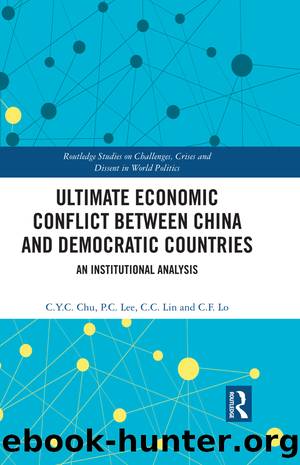Ultimate Economic Conflict between China and Democratic Countries by C.Y.C. Chu

Author:C.Y.C. Chu
Language: eng
Format: epub
Publisher: Taylor and Francis
Published: 2022-01-15T00:00:00+00:00
Encouraging Public Listing
Another positive sign of progress during the 2000s was the establishment of the SASAC in 2003. Reporting directly to the State Council, the SASAC was mandated to manage state assets (that is, capital investment in SOEs) and to facilitate the corporatization of SOEs. According to Fu (2016, p. 154), the SASAC took two steps to achieve this. The first was to standardise the Board of Directors of SOEs, which included setting a desirable size and composition of the SOE Board, requiring the setting up of subcommittees under the Board, and rebalancing powers between the chairman and the other positions. The second step was to promote SOEs to be listed in domestic or international stock markets with the hope of improving SOE governance under the pressure of external scrutiny. In addition to improving corporate governance, the policy encouraging public listing also aimed at raising capital, increasing the liquidity of state assets, and building up international reputations for the fast-rising Chinese companies.
All these regulatory and policy developments promoted another wave of Chinese companiesâ overseas listings. In addition to large SOEs, newly emerging Chinese private companies, especially those in the Internet area, were in dire need of capital that the Chinese capital market could not afford, as the market was still in its infancy and subject to strict government regulations. For example, the Shanghai Stock Exchange imposed an âIPO moratoriumâ in 2001 and 2004, respectively, completely banning new listings so as to calm the market and to prevent liquidity from rushing out of existing stocks and into new issues (Asian Corporate Governance Association [ACGA] Alan and Li, 2018, p. 24). The new emerging Chinese companies could thus only seek sources of capital abroad. At the same time, international investors were keen to include the emerging Chinese economy in their portfolios.
Overall, the number and economic weight of these US-listed Chinese companies increased sharply over the ten years between 2000 and 2010. Sina, Sohu and Neteas all became listed on the US Nasdaq in the early 2000s. This frenzy reached its climax in 2007, where 31 Chinese companies completed their US IPOs in that year. The 2008 financial crisis did not result in a large-scale setback for the Chinese economy, and since China was not greatly impacted by the financial tsunami, the 2008 crisis even made the shares of Chinese companies preferable investment targets.
To sum up, at the end of the first decade of the 21st century, China appeared healthy in its corporate governance transition. The legal framework had been established and appeared to match its economic growth. The SOE reforms, while somewhat lagging, continued to progress at a stable pace. The immaturity of its domestic capital market did not prevent ambitious Chinese entrepreneurs from seeking capital in the international pool. In addition to the funds collected, overseas listings also brought an international reputation and new management skills to Chinese companies.
Moving into the second decade of the 21st century, however, several issues arose from the immense overseas listings, and some reversals to the corporate governance reform were floated.
Download
This site does not store any files on its server. We only index and link to content provided by other sites. Please contact the content providers to delete copyright contents if any and email us, we'll remove relevant links or contents immediately.
| Arms Control | Diplomacy |
| Security | Trades & Tariffs |
| Treaties | African |
| Asian | Australian & Oceanian |
| Canadian | Caribbean & Latin American |
| European | Middle Eastern |
| Russian & Former Soviet Union |
The Secret History by Donna Tartt(18797)
The Social Justice Warrior Handbook by Lisa De Pasquale(12114)
Thirteen Reasons Why by Jay Asher(8761)
This Is How You Lose Her by Junot Diaz(6738)
Weapons of Math Destruction by Cathy O'Neil(6109)
Zero to One by Peter Thiel(5655)
Beartown by Fredrik Backman(5570)
The Myth of the Strong Leader by Archie Brown(5393)
The Fire Next Time by James Baldwin(5219)
How Democracies Die by Steven Levitsky & Daniel Ziblatt(5106)
Promise Me, Dad by Joe Biden(5063)
Stone's Rules by Roger Stone(5004)
A Higher Loyalty: Truth, Lies, and Leadership by James Comey(4818)
100 Deadly Skills by Clint Emerson(4817)
Rise and Kill First by Ronen Bergman(4673)
Secrecy World by Jake Bernstein(4612)
The David Icke Guide to the Global Conspiracy (and how to end it) by David Icke(4591)
The Farm by Tom Rob Smith(4413)
The Doomsday Machine by Daniel Ellsberg(4389)
